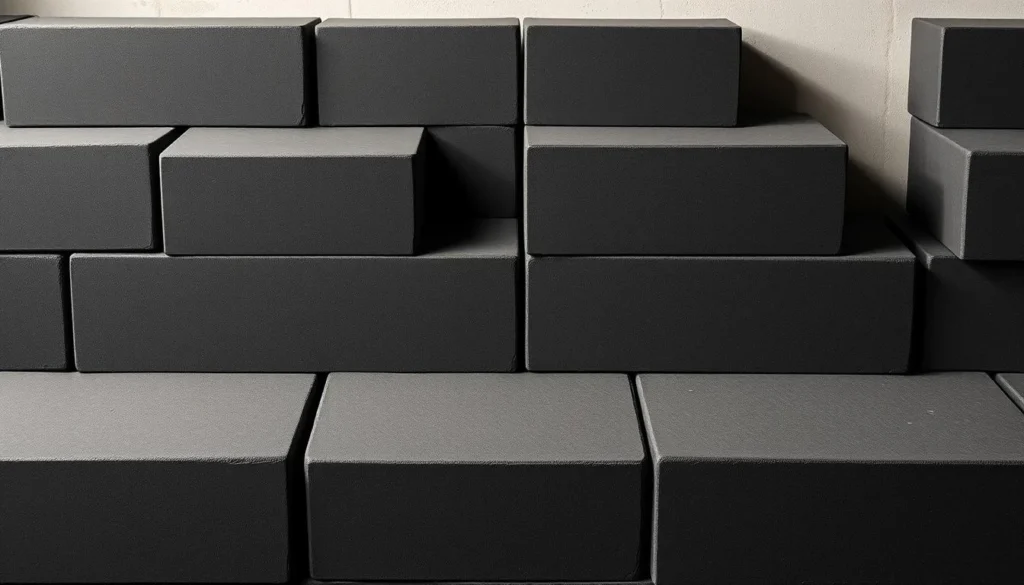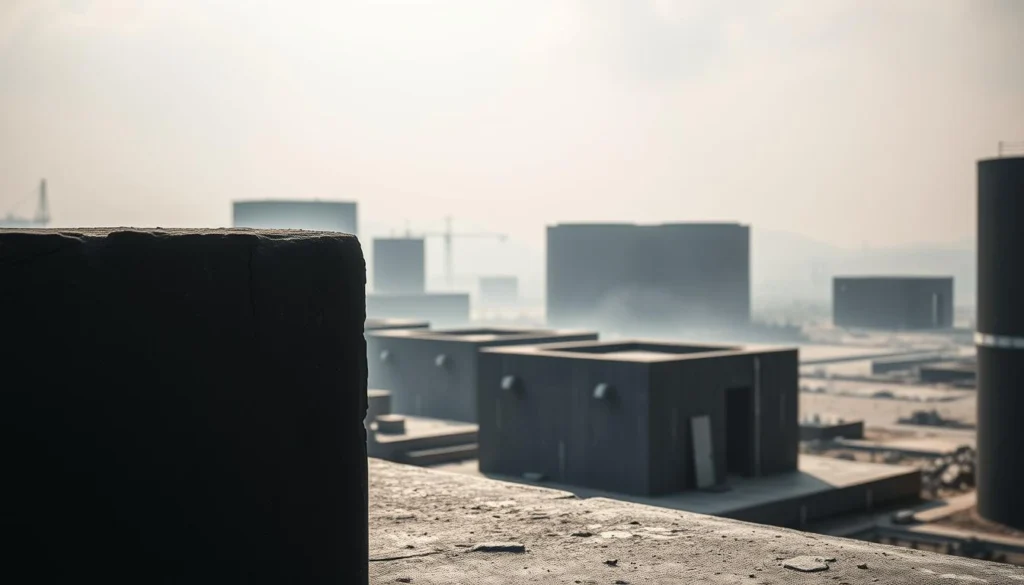Black Concrete: How It’s Made & Used in 7 Stunning Projects
Have you ever wondered how colored concrete is made? Black concrete is a favorite for modern buildings because of its sleek look.
Black concrete is used in many ways, like decorative driveways and bold walls. Its unique look makes it perfect for different projects.
Table of Contents
Key Takeaways
- Understanding the composition of black concrete
- Exploring the process of making colored concrete
- Discovering the various applications of concrete projects
- Learning about the benefits of using black concrete
- Examining 7 stunning projects that feature black concrete
What Is Black Concrete?
Black concrete is more than just a design choice. It’s a material with unique characteristics. You might be curious about what makes it stand out.
The Composition of Black Concrete
Black concrete gets its dark color from special materials. Black pigments or dyes are added to the mix. Carbon black is often used for its deep color.
The mix also includes the type of cement, aggregate, and admixtures. This ensures the concrete is strong and durable.

How Black Concrete Differs from Standard Concrete
Black concrete looks different from standard concrete. Standard concrete is gray, but black concrete has a dark color. This is thanks to special additives.
These additives can change the concrete’s thermal mass and look. The mix design is also adjusted for color consistency. This can be tricky in big projects.
Knowing these differences is key for architects, builders, and homeowners. It helps them get the look they want while keeping the concrete strong.
The History and Evolution of Black Concrete
Colored concrete has been around for centuries, shaping our built world. It’s interesting to note that ancient Romans used it in their structures. This shows how long colored concrete has been a part of our history.
Origins of Colored Concrete
The history of colored concrete starts with ancient construction. The Romans used it to make buildings and public spaces stand out. As building methods improved, so did ways to color concrete.
Modern Applications and Growing Popularity
Nowadays, black concrete is becoming more popular in city projects like the Spatial City. It’s used for architectural details, public areas, and decorations. Black concrete adds beauty and lasts long, making it a great choice for projects.
| Application | Benefits |
|---|---|
| Architectural Features | Aesthetic appeal, durability |
| Public Infrastructure | Low maintenance, thermal properties |
| Decorative Elements | Visual interest, design flexibility |

How Black Concrete Is Made
Making black concrete involves different methods, each with its own benefits. The process starts with picking the right materials and techniques. This ensures the concrete is both black and durable.
Using Black Pigments and Dyes
Adding black pigments or dyes is a common way to make black concrete. These pigments come from iron oxide or carbon black. They are mixed into the cement or aggregate to get the black color.
The amount of pigment needed depends on how dark the color should be.
- Iron oxide pigments give a range of black shades and are affordable.
- Carbon black pigments create a deeper, richer black color.
Carbon Black Method
The carbon black method uses carbon black, made from burning heavy petroleum products. It’s known for its deep, rich black color. The right amount of carbon black is added to the mix for the perfect shade.
Black Aggregate Method
Using black aggregate is another way to make black concrete. This method replaces some or all of the standard aggregate with black materials. Black aggregate can be basalt or other dark rocks.
This method not only makes the concrete black but also makes it more durable.
Key benefits of using black aggregate include:
- It makes the concrete more durable because of the aggregate’s hardness.
- It adds aesthetic appeal with a consistent black color.
Properties and Benefits of Black Concrete
Black concrete is a mix of beauty and function. Knowing its properties is key when using it in your projects.
Aesthetic Advantages
Black concrete’s main aesthetic advantage is its modern look. Its dark color adds depth and contrast to buildings. This makes it perfect for modern designs.
The Bruce C. Bolling Municipal Building is a great example. It shows how black concrete can enhance urban architecture.
Thermal Properties
Black concrete has unique thermal properties. It absorbs more heat than lighter colors. This can be good or bad, depending on the weather and use.
Durability Considerations
Black concrete is also very durable. It’s strong and lasts long. Adding certain pigments and using the carbon black method makes it even more resistant to weather and chemicals.
Knowing the benefits of black concrete helps you decide its use in your projects. It’s all about its looks, heat handling, and lasting power.
Step-by-Step Guide to Making Black Concrete
To make durable and beautiful black concrete, follow a simple guide. It’s not just about adding color. You need to pick the right materials and use the right techniques.
Materials and Tools You’ll Need
Here’s what you’ll need to make black concrete:
- Cement
- Aggregates (sand, gravel, or crushed stone)
- Black pigment or dye
- Water
- Admixtures (optional)
- Mixing equipment (drum mixer or mixing truck)
- Tamping tools
Choosing the right black pigment is key. You can pick from iron oxide or carbon black. The choice depends on the color you want and where you’re using it.
Mixing Process
Mixing well is important for color and strength. Here’s how to do it:
- Measure your ingredients carefully.
- Mix the dry stuff (cement, aggregates, and pigment) well.
- Add water slowly while mixing until it’s right.
- Use admixtures if needed to help with mixing or save water.
Curing Black Concrete Properly
Curing is key for black concrete’s durability. Proper curing means keeping it moist and at the right temperature.
- Keep it moist by spraying water often.
- Apply a curing compound to stop moisture loss.
- Stay away from extreme temperatures while curing.
Places like The Mslan Residence show how important curing is for great black concrete.
Common Challenges and Solutions When Working with Black Concrete
Working with black concrete can bring up several challenges. It’s important to know these issues to make your project a success.
Color Consistency Issues
Getting the same color in black concrete can be hard. This is because of different materials and mixing methods. To keep the color the same, use the same cement and aggregates for your project. Make sure the mixing ratio is the same and the concrete is finished by experts.
Preventing Efflorescence
Efflorescence, or salt deposits, can show up on black concrete. This can ruin its look. To stop this, apply a concrete sealer after it’s cured. Also, make sure the concrete is not too wet and cure it properly.
Maintenance Considerations
Keeping black concrete clean and sealed is key. Check it often for damage and fix it fast. Architects like Foreign Office Architects say keeping it up is crucial for its look and strength.
Knowing these challenges and how to solve them can help you work well with black concrete. This way, you can get the results you want for your projects.
Stunning Project 1: Chongae Canal Restoration
See how urban planning gets a boost with the Chongae Canal Restoration. This project shows black concrete’s power to revitalize city areas.
Project Overview and Design Concept
The Chongae Canal Restoration aimed to revive a key waterway in the city’s heart. It used black concrete for a modern yet classic look. Black concrete was picked for its beauty and lasting quality, perfect for this urban makeover.
Black Concrete Implementation Techniques
Using black concrete needed careful planning for a smooth finish. Techniques like black pigments and dyes were used for color consistency. Black aggregate also played a big role in the project’s look.
Environmental Integration and Public Response
The Chongae Canal Restoration merged new infrastructure with the environment. People loved the mix of modern design and history. As one person said, “
The restoration has brought new life to the area, making it a vibrant public space.
” This shows black concrete’s role in urban development.
Stunning Project 2: Bruce C. Bolling Municipal Building
Boston’s cityscape has changed with the Bruce C. Bolling Municipal Building. It’s a key spot for local government and a masterpiece of design.
Architectural Vision and Urban Context
The Bruce C. Bolling Municipal Building was made with a bold vision. It fits perfectly into Boston’s cityscape. Its design honors the city’s past while exploring new architectural ideas.
The building’s black concrete façade stands out. It adds beauty to the city’s look.
Innovative Black Concrete Applications
Black concrete was a key choice for the building. It looks great and lasts long. It also helps with keeping the building cool.
This use of black concrete sets a new benchmark for city buildings.
“The Bruce C. Bolling Municipal Building is a landmark example of how modern materials and techniques can be used to create functional, yet aesthetically pleasing public spaces.”
— Architectural Review
Community Impact and Architectural Recognition
The building has made a big difference in the community. It’s a place where people come together and a sign of Boston’s forward thinking. It’s been praised for its design and how it fits into the city.
Its design is a mix of function and beauty. It shows how cities can grow while staying beautiful and sustainable.
Stunning Project 3: The Mslan Residence
The Mslan Residence is a standout in modern architecture. It uses black concrete in a creative way. Designed by Foreign Office Architects, it shows how materials can be both beautiful and functional.
Design Philosophy by Foreign Office Architects
Foreign Office Architects is known for bold architectural designs. They use unusual materials and methods. The Mslan Residence is a perfect example of this.
Their goal was to blend the built environment with nature. Black concrete was key. It adds drama and shows the project’s focus on sustainability and lasting quality.
Black Concrete Structural Elements
The Mslan Residence features black concrete in many parts. From the base to the walls, it’s everywhere. The architects used it to create interesting shapes and textures.
These elements also help with keeping the inside cool. This means less energy is needed to keep the house comfortable.
Interior and Exterior Integration
The Mslan Residence is known for its smooth transition between inside and outside. Black concrete is used both inside and out. This makes the whole place look connected and beautiful.
| Feature | Description | Benefit |
|---|---|---|
| Black Concrete | Used in structural elements and façade | Aesthetic appeal and thermal mass |
| Interior-Exterior Integration | Seamless transition between indoor and outdoor spaces | Enhanced visual cohesion and sense of space |
| Sustainable Design | Incorporation of sustainable materials and practices | Reduced environmental impact and energy efficiency |
Stunning Project 4: Spatial City Urban Development
Spatial City Urban Development is changing the face of urban planning. It combines new design ideas with green practices. This sets a high standard for modern cities.
Concept and Planning Approach
The project started with a detailed plan to create a unified city. The team used a complete approach, adding parks, walkable areas, and good public transport. Urban planning expert, Jane Doe, said,
‘The Spatial City project is a masterclass in urban renewal, blending functionality with aesthetic appeal.’
Black Concrete in Public Infrastructure
Black concrete is a key feature in Spatial City. It makes the city look good and is easy to keep up.
Black concrete gives the city a unified look. It’s used in paths, building walls, and art. This adds to the city’s sleek look.
Sustainability and Longevity Considerations
Sustainability was key in Spatial City’s design. The project includes green features like smart lights and water catchment systems. Black concrete helps keep the city cool, saving energy. This makes Spatial City a leader in green urban planning, showing that longevity and caring for the environment can work together.
Stunning Project 5: Size de Camas Cultural Center
When you visit the Size de Camas Cultural Center, you’ll see black concrete in a new light. This place is a mix of modern design and beauty. It shows how buildings can be both useful and lovely.
Architectural Significance and Design Elements
The Size de Camas Cultural Center stands out with its bold design. Its black concrete walls are key to its look. Black concrete adds beauty and lasts long, keeping the building cool.
Black Concrete Facades and Features
The black concrete on the center’s walls is a smart choice. It makes the building look amazing. It also helps save energy.
Cultural Context and Visitor Experience
The Size de Camas Cultural Center is a heart of the community. It hosts many events and shows. Visitors can see the black concrete up close and enjoy the culture.
This center shows how black concrete can make a big impact in architecture. It fits perfectly with the culture, making visits special.
Conclusion: The Future of Black Concrete in Modern Architecture
Black concrete is a versatile and striking material that can elevate modern architecture. Its unique aesthetic and durability make it a top choice for architects and builders. They use it to create structures that are both visually striking and long-lasting.
The future of black concrete looks bright. It has potential applications in many modern architecture projects. From urban infrastructure to residential buildings, black concrete is set to make a big impact.
As the construction industry evolves, we’ll see more innovative uses of black concrete. This will push the boundaries of what’s possible in building design. Black concrete is set to play a significant role in shaping urban landscapes of tomorrow.
FAQ
What is black concrete and how is it different from regular concrete?
Black concrete is a special type of concrete. It gets its dark color from black pigments or additives. It looks different and might work better in certain ways than regular concrete.
How is black concrete made?
To make black concrete, black pigments or dyes are added to the mix. There are two main ways to get the black color: the carbon black method and the black aggregate method.
What are the benefits of using black concrete in construction projects?
Black concrete adds beauty and has good thermal properties. It’s also very durable. It’s been used in projects like the Bruce C. Bolling Municipal Building and the Chongae Canal Restoration.
Can black concrete be used in any type of construction project?
Yes, black concrete is versatile. It’s used in urban projects like Spatial City and in cultural centers like Size de Camas Cultural Center.
How do architects achieve color consistency in black concrete?
Getting the color right in black concrete is tricky. But, it’s possible with the right pigments and mixing. Architects like Foreign Office Architects have successfully used black concrete in their designs.
What are some common challenges when working with black concrete?
Some issues with black concrete include getting the color even, stopping efflorescence, and keeping it looking good over time.

